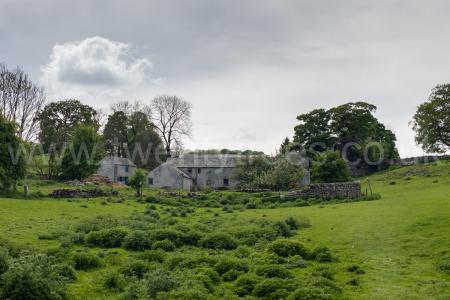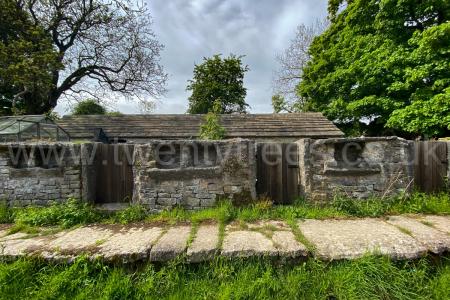Europe, British Isles, North-Central England, Derbyshire Dales, Monyash [Map]
Monyash is in Derbyshire Dales.
In 1370 Sir Godfrey Foljambe (age 26) the younger (son of the eminent lawyer and retainer of John of Gaunt (age 29)) confirmed him in possession of part of the manors of Over Haddon [Map], Rowsley [Map], Wardlow [Map], Monyash [Map] and Chelmorton [Map] in Derbyshire, which were to Gaunt (age 29) himself.
The River Lath rises near Monyash [Map] flowing through Lathkill Dale [Map], where there are a number of seasonal springs, to Conksbury Bridge, Derbyshire [Map] then Alport [Map] where it is joined by the River Bradford. After Alport [Map] the River Lath flows east to a point around 600m south of Haddon Hall [Map] where it joins the Derbyshire River Wye.
Europe, British Isles, North-Central England, Derbyshire Dales, Monyash, Ashford Moor Barrow [Map]
Ashford Moor Barrow is also in Peak District Bronze Age Barrows.
Thomas Bateman 1845. The first barrow [Map] opened this season was a small one situate near Hunter-mere, on Ashford Moor, which was (on the 23d of April, 1845) divided into four sections, in order to leave no part of it unexplored; it was formed with great exactness having a slight ditch or depression surrounding the base and although so perfect and uninjured in its appearance it was found upon examination to have been previously explored; owing to this circumstance the contents were uninteresting; near the surface was found a small iron arrow-head probably of much later date than the original interments, of which the remains in the shape of small pieces of bone were found promiscuously in the tumulus. In the same manner were found five instruments of flint of no particular interest, sundry chippings of the same, a piece of smoothly-rubbed sandstone, and rats' bones as usual; on the surface of the natural soil there was a small quantity of charcoal strewed about.
Europe, British Isles, North-Central England, Derbyshire Dales, Monyash, Benty Grange Barrow [Map]
Benty Grange Barrow is also in Prehistoric Peak Distrct Roman and Saxon Barrows.
Benty Grange. May 3rd. - It was our good fortune to open a barrow which afforded a more instructive collection of relics than has ever been discovered in the county, and which are not surpassed in interest by any remains hitherto recovered from any Anglo-Saxon burying place in the kingdom.
The barrow [Benty Grange Barrow [Map]], which is on a farm called Benty Grange, a high and bleak situation to the right of the road from Ashbourn to Buxton, near the eighth milestone from the latter place, is of inconsiderable elevation, perhaps not more than two feet at the highest point, but is spread over a pretty large area, and is surrounded by a small fosse or trench. About the centre and upon the natural soil, had been laid the only body the barrow ever contained, of which not a vestige besides the hair could be distinguished. Near the place which, from the presence of hair, was judged to have been the situation of the head, was a curious assemblage of ornaments, which, from the peculiarly indurated nature of the earth, it was impossible to remove with any degree of success. The most remarkable are the silver edging and ornaments of a leathern cup, about three inches diameter at the mouth, which was decorated by four wheel-shaped ornaments and two crosses of thin silver, affixed by pins of the same metal, clenched inside.
The other articles found in the same situation consist of personal ornaments, the chief of which are two circular enamels upon copper 1¾ diameter, in narrow silver frames, and a third, which was so far decomposed as to be irrecoverable; they are enamelled with a yellow interlaced dracontine pattern, intermingled with that peculiar scroll design, visible on the same class of ornaments figured in Vestiges p. 25, and used in several manuscripts of the Vllth Century, for the purpose of decorating the initial letters. The principle of this design consists of three spiral lines springing from a common centre, and each involution forming an additional centre for an extension of the pattern, which may be adapted to fill spaces of almost any form. Mr. Westwood has shown in a most able paper in the 40th No. of the Journal of the Archæological Institute, that this style of ornamentation is peculiar to the Anglo-Saxon and Irish Artists of the period before stated. The pattern was first cut in the metal, threads of it being left to show the design, by which means cells were formed, in which the enamel was placed before fusion, the whole being then polished became what is known as Champ-levé enamel. There was also with these enamels a knot of very fine wire, and a quantity of thin bone variously ornamented with lozenges &c, which was mostly too much decayed to bear removal; it appeared to have been attached to some garment of silk, as the glossy fibre of such a fabric was very perceptible when they were first uncovered, though it shortly vanished when exposed to the air. Proceeding westward from the head for about six feet, we arrived at a large mass of oxidyzed iron, which, being removed with the utmost care, and having been since repaired, were unavoidably broken, now presents a mass of chainwork, and the frame of a helmet. The latter consists of a skeleton formed of iron bands, radiating from the crown of the head, and riveted to a circle of the same metal which encompassed the brow: from the impression on the metal it is evident that the outside was covered with plates of horn disposed diagonally so as to produce a herring-bone pattern, the ends of these plates were secured beneath with strips of horn corresponding with the iron framework, and attached to it by ornamental rivets of silver at intervals of about an inch and a half from each other; on the bottom of the front rib, which projects so as to form a nasal, is a small silver cross slightly ornamented round the edges by a beaded moulding; and on the crown of the helmet is an elliptical bronze plate supporting the figure of an animal carved in iron, with bronze eyes, now much corroded, but perfectly distinct as there presentation of a hog. There are too, many fragments, some more or less ornamented with silver, which have been riveted to some part of the helmet in a manner not to be explained or even understood, there are also some small buckles of iron which probably served to fasten it upon the head. Amongst the chainwork is a very curious six-pronged instrument of iron, in shape much like an ordinary hay-fork, with the difference of the tang, which in the latter is driven into the shaft, being in this instrument flattened and doubled over so as to form a small loop apparently convenient for suspension; whether it belonged to the helmet or the corselet, next to be described, is uncertain. The iron chainwork already named, consists of a large number of links of two kinds, attached to each other by small rings half an inch diameter; one kind are flat and lozenge, shaped, about an inch and a half long; the others are all of one kind but of different lengths, varying from 4 to 10 inches. They are simply lengths of square rod iron with perforated ends, through which pass the rings connecting them with the diamond shaped links; they all show the impression of cloth over a considerable part of the surface, and it is therefore no improbable conjecture that they would originally constitute a kind of quilted cuirass, by being sewn up within, or upon a doublet of strong clotL The peculiarly indurated and corrosive nature of the soil in this barrow is a point of some interest, and it will not be out of place to state that such has generally been the case in tumuli in Derbyshire, where the more important Saxon burials have taken place, whilst the more ancient Celtic interments are generally found in good condition owing to there having been no special preparation of the earth, which in these cases has undergone a mixing or tempering with some corrosive liquid; the result of which is the presence of thin ochrey veins in the earth, and the decomposition of nearly the whole of the human remains. The following extract from Professor Worsaae's Antiquities of Denmark, illustrates the helmet which is the only example of the kind hitherto discovered either in this country or on the Continent.
"The helmets (of the ancient Scandinavians) which were furnished with crests, usually in the form of animals, were probably in most cases only the skins of the heads of animals, drawn over a framework of wood or leather, as the coat of mail was usually of strong quilted linen or thick woven cloth."
To this the translator of the English edition appends the important information, that "the animal generally represented was the boar; and it is to this custom that reference is made in Beowulf where the poet speaks of the boar of gold, the boar hard as iron."
"Swyn eal - gylden, Eofer Iren - heard."
Nor are allusions to this custom of wearing the figure of a boar - not in honour of the animal, but of Freya, to whom it was sacred - confined to Beowulf, they are to be found in the Edda and in the Sagas; while Tacitus in his work, De Moribus Germanorum, distinctly refers to the same usage and its religious intention, as propitiating the protection of their Goddess in battle. As a further illustration, not only of the helmet, but also of the chainwork, the following extracts from Beowulf are transcribed from Mr. 0. R. Smith's Collectanea Antiqua, vol. II, p. 240.
eofer-líc sciónon ofer-hleor beran; ge-hroden golde fah and fyr-heard, ferh-wearde heóld. Be-fongen freá-wrásnum, swa híne fyrn-dagum worhte waspna smith, wundrum teóde, be-sette swín-lícum, that hine sythan nó brond né beado-mecas bitan ne meahton: Æt thæm áde wæs eth-ge-syne swát-fah-syrce swyn eal-gylden, eofer íren heard; Hé thá in-beran eafor heáfod-segn, heago-steápne helm, [se] are-byman, guth-sweord geáto-líc:
They seemed a boar's form to bear over their cheeks; twisted with gold, variegated and hardened in the fire, this kept the guard of life: Surrounded with lordly chains, even as in days of yore the weapon smith had wrought it, had wondrously furnished it, [swine,] had set it round with the shapes of that never afterwards brand or war-knife might have power to bite it; At the pile was easy to be seen the mail shirt covered with gore, the hog of gold, the boar hard as iron: Then commanded he to bring in the boar, an ornament to the head, the helmet lofty in wars, the grey mail coat, the ready battle sword.
Note. The original and a reconstructed helmter are on display at the Weston Park Museum, Sheffield.
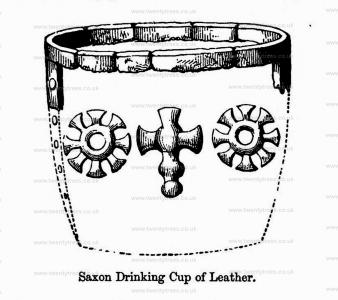

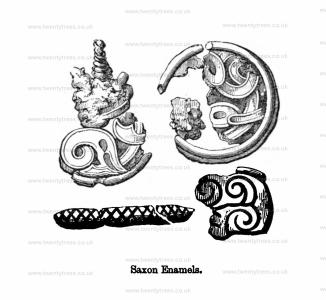
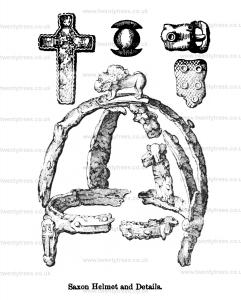
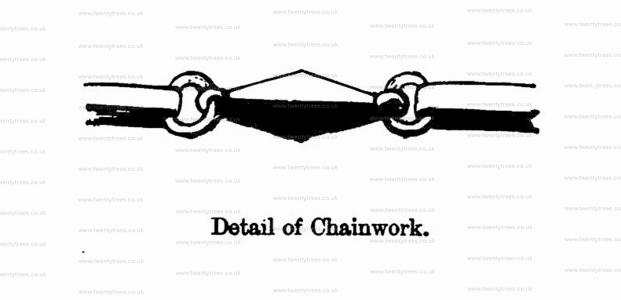




Europe, British Isles, North-Central England, Derbyshire Dales, Monyash, Burton Moor Barrow [Map]
Burton Moor Barrow is also in Prehistoric Peak Distrct Roman and Saxon Barrows.
Over Haddon. On the 30th of April a barrow [Map] [Burton Moor Barrow [Map]] near Over Haddon, in land called Grindlow, was examined as completely as the meeting of three walls on its summit would allow. It had been much mutilated; but fortunately the primitive interments lay too deep to receive injury from the labours of those in search of stone, by whom an important interment of secondary date had been destroyed. The original deposit had been made on the rock a little below the natural surface, and about 5 feet from the top of the mound; it comprised three skeletons, laid in the usual contracted position, two of which were females; with them were one or two rude instruments of flint, and a fine collection of jet ornaments, 73 In number, which form a very handsome necklace. Of these 26 are cylindrical beads, 39 are conical studs, pierced at the back by two holes meeting at an angle in the centre; and the remaining 8 are flat dividing plates, ornamented in the front with a punctured chevron pattern, superficially drilled in the jet; 7 of them are laterally perforated with three holes, to admit of their being connected by a triple row of the cylindrical beads, whilst the 8th, which is of bone, ornamented in the same style, has nine holes at one side, which diminish to three on the other by being bored obliquely. Above these bodies, which were covered with stone, the mound was of unmixed earth, very compact and clayey, and between the stone and earth were many pieces of calcined bone, and numerous splinters of the leg bones of large animals, some of which are likely to have been used as points for weapons. In the earth near the summit of the barrow were some relics of a later interment, probably of a distinguished Saxon, with whom had been deposited a circular enamel, of which only the silver plated frame remained, the latter is engrailed on the front, and engraved with a lozengy pattern round the edge; and a bowl of thin bronze, very neatly made, with a simple hollow moulding round the edge, which when complete was 7 inches diameter, and appears to have had two handles soldered or cemented to the sides. The bowl was broken when found, and no handles were discovered; but it is probable that both they and some other ornaments, as well as another of the bone plates with 9 perforations, which is wanting to complete the necklace, would have been found if the triple wall could have been removed, as the point of junction was directly over the place where the interments lay, which were exhumed by a dangerous undercutting.
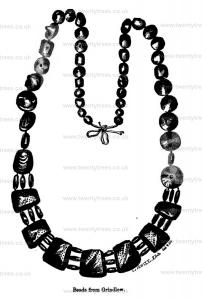
Europe, British Isles, North-Central England, Derbyshire Dales, Monyash, Calling Low Barrow 1 [Map]
Calling Low Barrow 1 is also in Peak District Bronze Age Barrows.
Thomas Bateman 1846. On November 30th, 1846, were opened two barrows near Middleton, upon the Calling Lowe Farm, which probably has acquired the denomination of "Lowe" from the presence of these two tumuli, doubtless once well known and venerated. The first barrow [Map] [Note. Calling Low Barrow 1 [Map]] is situate near the edge of the Lowe Dale, at the termination of a stony ridge, which has been taken advantage of in forming the shape of the tumulus, without the expenditure of much labour. The skeleton, with the knees drawn up lay on its right side, in an oblong cist, the extremities of which were respectively north-east and south-west, and which was constructed of flat limestones, arranged in a depression in the rock, about eighteen inches in depth, near the centre of the barrow; near the pelvis were two instruments of calcined flint, namely, a spear-head and a circular-ended instrument, and above the body lay the bones of a dog's hind leg, and a round ball of sandstone about two inches and a half in diameter. Many rats' bones accompanied this interment which, owing to its proximity to the surface, was very much decayed.
Europe, British Isles, North-Central England, Derbyshire Dales, Monyash, Calling Low Barrow 2 [Map]
Calling Low Barrow 2 is also in Peak District Bronze Age Barrows.
Thomas Bateman 1846. The other barrow [Map] [Note. Calling Low Barrow 2 [Map]] is a lowly sepulchre, not rising more than a foot above the surrounding field, and situated nearer the Yolgrave and Buxton road than the preceding one is. About two feet from the surface, in the centre, and consequently beneath the natural level, was a skeleton inclosed in a mass of stiff earth, which had almost effected the destruction of the bones; near the pelvis of this body a rude instrument of calcined flint was found; it was the only relic deposited with this interment, which had, undoubtedly, supplanted the rightful occupants of the tomb: this circumstance was proved by the discovery of the remains of two previous interments, which had been thrown on one side to make room for the intruder. These I relics comprised many pieces of two unbumt skeletons, parts of two highly-ornamented drinking-cups, and many bones of animals, amongst which the remains of rats were as usual most numerous.
Europe, British Isles, North-Central England, Derbyshire Dales, Monyash, Grind Low Barrow [Map]
Grind Low Barrow is also in Peak District Bronze Age Barrows.
Over Haddon. May 4th we partially excavated the remains of Grindlow [Map] proper, originally a large cairn 25 yards across, wholly composed of stones of all sizes, but now almost demolished: we were therefore unsuccessful in our search for interments, but found broken human bones, accompanied by those of the rat, in every direction. We also met with a broken lance head of flint, and part of the tusk of a wild boar.
Europe, British Isles, North-Central England, Derbyshire Dales, Monyash, Haddon Field Barrow [Map]
Haddon Field Barrow is also in Peak District Bronze Age Barrows.
Haddon Field. On the 20th of August, after repeated disappointments from the unusual wetness of the summer, we opened a barrow [Haddon Field Barrow [Map]] on Haddon Field, near Bakewell; for access to which we were indebted to the kindness of the Rev, Frederick, and Lady Adeliza Norman, who also attended during the opening. The mound was of a regular convex form, about 16 yards diameter and not more than 4 feet high. A cutting through the centre passed downwards through about 12 inches of earth, succeeded by large limestones disposed without regularity or any apparent design, although their removal disclosed the only interment that was found: this, owing to a natural rise in the land about the middle of the barrow, was not more than 2 feet 6 inches from the surface. The skeleton lay on its left side in the usual contracted attitude, upon a thin bed of charred wood strewed on the natural level of the land a few inches only above the rock; the head pointed west south-west; the elbows were bent so as to allow the hands to be brought in front of the face; and near the lower part of the back was a small earthen drinking cup, 6½ inches high, very neatly ornamented with a vandyked pattern; close beneath which were three useful implements, an arrow head of flint that had acquired an opaque grey tint from partial calcination, a mesh rule for netting or else a potter's modelling tool, 6¼ inches long, rounded at the ends, cut from a horn of the red deer, and a very small brazen awl, which, when found, showed slight but distinct traces of its wooden handle. These objects would seem more appropriately to have accompanied a female than a male corpse, yet the size and general appearance of the bones indicate the latter as the sex of the deceased. The measurements of the long bones are -
Femur 18½in
Tibia 14¼in
Humerus 13in
The skull (see No. 237 of the list) is that of a man of upwards of forty years of age; it is a characteristic example of the ancient British type, and being more fully described in the list, calls for no further remark in this place than to observe that it possesses a peculiar flattening of the hinder part, extending from the upper edge of the occipital bone to those of the parietals adjoining the lamdoidal suture, a feature by no means uncommon in crania from barrows of the same remote antiquity, and which may be attributed to some prevailing method of nursing during infancy.
One or two teeth of animals and the least possible trace of rats' bones, with one small bit of primitive earthenware, were found in the digging, but no indication of other interments could be seen, although much of the centre of the mound was cut away in the hope of making some further discovery.
Europe, British Isles, North-Central England, Derbyshire Dales, Monyash, High Low [Map]
Ten Years' Digging Appendix. On the 10th of February, 1849, a person engaged in levelling about an old stone quarry in land near Monyash, called High Low [Map], met with numerous bones, both of men and animals, as usually found in tumuli that have been disturbed; a circumstance here recorded for the purpose of establishing the fact of a barrow having existed at High Low, as the name would indicate.
Europe, British Isles, North-Central England, Derbyshire Dales, Monyash, Meadow Place Barrow [Map]
Meadow Place Barrow is also in Peak District Bronze Age Barrows.
Youlgrave. On the 16th of November we opened a small barrow [Map] [Meadow Place Barrow [Map]] in a field on Meadow-place Farm, called Greenstor Meadow, close to the Conksbury road-side. The land having long been under tillage may account for the flatness of the barrow, and for the little success that attended our researches, which were rewarded by a few scattered articles only, there being no perfect interment found, although we detected remains of two human bodies, one of them calcined. There were also bones of rats, the tibia of a cow, a few instruments of flint, and a good specimen of a spear of the most primitive description, made from a large splinter of dense animal bone, nicely ground or rubbed to a point. It measures seven inches in length, and illustrates the account of Tacitus wherein he describes the more barbarous German hordes as using bone points to their weapons, owing to their ignorance of metal.
Europe, British Isles, North-Central England, Derbyshire Dales, Monyash, One-Ash Grange Farm [Map]
1147. One-Ash Grange Farm [Map] was originally settled in 1147 as a farm for Roche Abbey [Map]. In 1700 the farm was owned by the Bowman family who were granted a license to hold Quaker meetings there. The Grange has an unusual row of pigstyes.
